KARACHI: A broken road passing through half-covered drains and a stench mark the way to the country’s billion dollars tannery industry located in the Korangi area, where factories are abuzz with activity these days due to post-Eid business rush.
Once inside a factory, the first thing one experienced was the unbearable pungent smell emanating from raw material and chemicals used for processing. Labourers, however, seemed to be least bothered by the foul smell while working amid piles of raw and semi-treated hides.
“Eid has gone but our work has just begun and there is no time for leisure,” said Tariq Zaman, working as a supervisor at the tannery, adding that the process to treat skins had started at his factory receiving material from across the country.
The skins of sheep and cows, Mr Zaman explained, were considered the best because of their softness and it was important to preserve the raw material immediately to prevent damage.
High cost of production makes Pakistani products uncompetitive in the international market
According to the Pakistan Tanners’ Association (PAT) estimates, around 1.5 million animals were sacrificed this Eidul Azha in Karachi while 7.5 million animals were slaughtered across Pakistan.
The Karachi Metropolitan Corporation, however, had claimed to have collected 1.7m offal during the three-day festival.
It is said that 30pc of the total produce of the tannery business comes from the collections made during the Eid.
Explaining the different stages of the tanning process, Gul Mohammad, a helper at the unit, said the first step was to take out clean portions of the raw material and rub salt on it. The material was left for some days in salt and then soaked in water for 12 hours to make it a bit soft and extend its shelf life.
The process is followed by application of a number of chemicals during which the material is soaked, cooked and processed on multiple machines. “This helps to remove blood, meat, fat and hair and make the skin and hide smooth and clean,” he said.
The aggressive treatment turned the material into blue and on that stage it is washed with water and soap and later mechanically dried out. “In the crust stage, the processed skin is measured and tagged and retreated with chemicals. Later, it is hanged on the top floor for a day or two, depending upon the weather, so that it gets dry in the open,” he said, adding that it’s not the final product yet.
At the next stage, the leather is ironed making it softer and flawless. “It takes between 15 to 20 days that the leather gets ready for dyeing for which we have a separate factory. The entire processed leather is transported there and then brought back for a finishing touch and to make different products from the dyed leather, according to our clients’ orders,” he said.
Highlighting his professional struggle, Mr Zaman said he joined the factory as a cleaner in 1997 and was in charge of the unit at present. “Education matters. My progress has much do with my qualification as I had done a diploma in leather processing. There are many workers here who joined the factory before me but still working on the same position, because they are illiterate,” he observed.
In reply to a question about occupational hazards, Mohammad Danish Khan, the factory owner and former PAT chairman, said: “As you can see, workers are wearing leather boots and gloves but it’s their choice not to wear face masks to protect themselves from chemical fumes and smell. They were provided with safety gear but they refused to wear. Factories handling raw animal skins have similar conditions abroad as well.”
So far, he said, the factory had received 50,000 sheep skins, 8,000 to 10,000 goat skins and 5,000 camel hides.
The major obstacle to increase in leather exports, currently earning about $1.2 billion, he said, was the high cost of production that made Pakistani products uncompetitive in the international market.
“The government must provide us with electricity and gas on subsidised rates and refund our Rs200 billion stuck in the sales tax. We need to improve image of our country in the international market. As for Karachi, somebody needs to own this city contributing 62pc revenue to the exchequer,” he added.
Published in Dawn, October 5th , 2015
On a mobile phone? Get the Dawn Mobile App: Apple Store | Google Play















































Dear visitor, the comments section is undergoing an overhaul and will return soon.